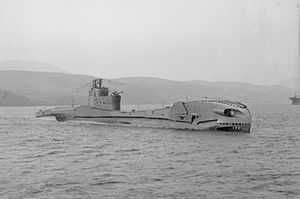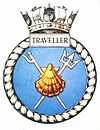HMS Traveller (N48)
 HMS Traveller in the Gareloch (southwest Scotland), in April 1942 | |
| Career (UK) | |
|---|---|
| Name: | HMS Traveller |
| Builder: | Scotts, Greenock |
| Laid down: | 17 January 1940 |
| Launched: | 27 August 1941 |
| Commissioned: | 10 April 1942 |
| Fate: | sunk on 4 December 1942 |
| Badge: |
 |
| General characteristics | |
| Class and type: | British T class submarine |
| Displacement: | 1,090 tons surfaced 1,575 tons submerged |
| Length: | 275 ft (84 m) |
| Beam: | 26 ft 6 in (8.08 m) |
| Draught: | 16.3 ft (5.0 m) |
| Propulsion: | Two shafts Twin diesel engines 2,500 hp (1.86 MW) each |
| Speed: | 15.25 knots (28.7 km/h) surfaced Nine knots (20 km/h) submerged |
| Range: | 4,500 nautical miles at 11 knots (8,330 km at 20 km/h) surfaced |
| Test depth: | 300 ft (91 m) max |
| Complement: | 61 |
| Armament: | Six internal forward-facing torpedo tubes Two external forward-facing torpedo tubes Three external backward-facing torpedo tubes Six reload torpedoes 4 inch (100 mm) deck gun Three anti-aircraft machine guns |
HMS Traveller (N48) was a T-class submarine of the Royal Navy. She was laid down by Scotts, Greenock and launched in August 1941.
Career
Traveller spent most of her career serving in the Mediterranean. She was unsuccessful in most of her attacks, sinking the Italian merchantman Albachiara, but launching failed attacks against the Italian merchant ship Ezilda Croce, the Italian 'small light cruiser' Cattaro (the former Yugoslavian Dalmacija), the Italian tanker Proserpina (the former French Beauce) and the Italian torpedo boats Castore and Ciclone. She also claimed to have attacked two so far unidentified submarines.[1]
Traveller left Malta on 28 November 1942 for a patrol in the Gulf of Taranto. She carried out a reconnaissance of Taranto harbour for a Chariot human torpedo attack (Operation Principal). The submarine did not return from the operation and was reported overdue on 12 December. She probably struck an Italian mine on or about 4 December.[2]
During the War Traveller was adopted by the Borough of Leyton in London as part of Warship Week. The plaque from this adoption is held by the National Museum of the Royal Navy in Portsmouth.[3]
References
- ↑ HMS Traveller, Uboat.net
- ↑ Submarine losses 1904 to present day, RN Submarine Museum, Gosport
- ↑ Warship Weeks: Adopting Naval Vessels in World War Two | Royal Naval Museum at Portsmouth Historic Dockyard
Publications
- Colledge, J. J.; Warlow, Ben (2006) [1969]. Ships of the Royal Navy: The Complete Record of all Fighting Ships of the Royal Navy (Rev. ed.). London: Chatham Publishing. ISBN 978-1-86176-281-8. OCLC 67375475.
- Hutchinson, Robert (2001). Jane's Submarines: War Beneath the Waves from 1776 to the Present Day. London: HarperCollins. ISBN 978-0-00-710558-8. OCLC 53783010.
| ||||||||||||||||||||||||||||||||